The fabulous and amazing plant, the nymphy, fascinates the beauty of huge leaves and the tenderness of blooming flowers. Water culture can turn the usual aquarium in the motley "miracle - thickets." How to plant nymph in aquarium? How to care for a water plant? How is culture multiplied? About this today's article.
Nymphi in aquarium, plant description
- Nymphi or, as it is also called, water lily, is an extensive genus of aquatic plants belonging to the family of pita.
- Often the nymph is confused with a water plant - a Kubashka, which represents a separate genus of the same family of pita.
- The area of \u200b\u200bnatural growth of the genus is quite extensive and applies to water basins of regions with a tropical, subtropical, moderate and equatorial climate.
- In nature, the pita can be very long and reach 1-1.5 meters (height). Under the aquarium, the length of the plant usually does not exceed 50 cm. And if the dwarf shapes are used for the decoration, the length of the plant will be even smaller.
- Nymphi is a perennial aqueous fast-growing plant with very beautiful leaves and gentle flowers. The leaves are located on the stiff, and the smaller the light in the aquarium, the more the petioles are extended.
- Nimfei underwater leaves are one of the main decorations of this exotic plant. They are different coloring: from a gentle olive to juicy burgundy. Large heart-shaped leaves can be slightly elongated either, on the contrary, rounded shape. Nymphi in the aquarium forms two types of leaves: underwater and floating on the surface.
- Under favorable conditions of detention, nymphany blooms in aquarium with gentle floating white-pink flowers. The blooming nymph in the aquarium is an unforgettable spectacle! The flowering period is usually on the second half of summer. Immediately before flowering, the plant "produces" floating rigid leaves with a color-seater.
- Interesting the fact that Nymphi, among other things, is also fruitful culture. The fruit in the form of small berries appears and ripen also under water.
- Outwardly, the root of the nymphy looks quite powerfully, it is thickened and creeping. But in reality, the root processes are gentle and fragile, so when planting plants in the aquarium, only fine-flow pebbles or sand, helping to avoid damage to the roots. From the main root of the nymfei, white filamentous processes are departed, which are used in reproduction of culture.
- Nymphi is a large aquatic water plant for which only a large, bulk aquarium is suitable. Most often, the aquarists grow a red or tiger variety of Nymfei.
- Nymphi is considered a light and thermal-loving culture characterized by high decorative attractive qualities and a long period of flowering.

Nymphi Aquarium, Application
- Thanks to high decorative qualities, nymphy is widely used to decorate aquariums or artificial reservoirs.
- If nymph is grown in an open outdoor reservoir, depending on the time of year, it is necessary to change the location of the plant. In the summer - the plant is placed on shallow water, and in winter - they are translated into deeper (warm) places of the reservoir.
- Nimfei rhizomes are rich in starch and can be used to obtain starch or flour.
- Seeds of Nimifi if to fry them, can be used as a coffee beverage.
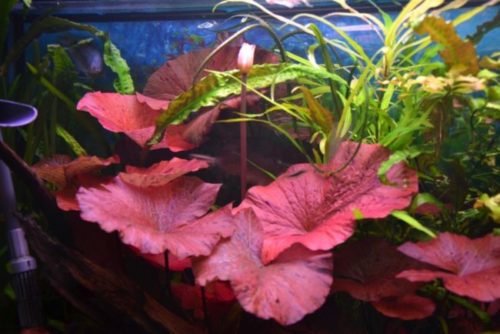
Nymphi in aquarium, interesting facts
- Translated from the Latin word "Nymphi" means "doll". Many connect the name of this beautiful water plant with the word "nymph" that denotes the beautiful ancient Greek goddess of nature. According to ancient legend, a beautiful nymph was unrequited in love with Hercules, which was why she suffered and cried. The wonderful creation, the goddess died of grief and turned into an unusually gentle and beautiful flower growing on the surface of the water.
- In Russian beliefs, this plant was often personalized with mermaids, woven into the braids beautiful blurred nymphy flowers.
- Interesting feature of the blossom of Nimfei: At night, her flower closes and goes under the water so that in the morning to pop up and dismiss again. Although these types of nymphs are cultivated, which bloom only at night.
- At the underwater leaves, Nimfei also has its own "secrets". They reach the greatest attractiveness in the aquarium due to the location of them in the thickness of the water. If at least one sheet begins to "reach" to the surface of the water, everyone else will strive to do the same. Thus, only cutters will be visible in the aquarium, which cannot be allowed in any way, otherwise the plant will fully lose its decorative attractiveness.
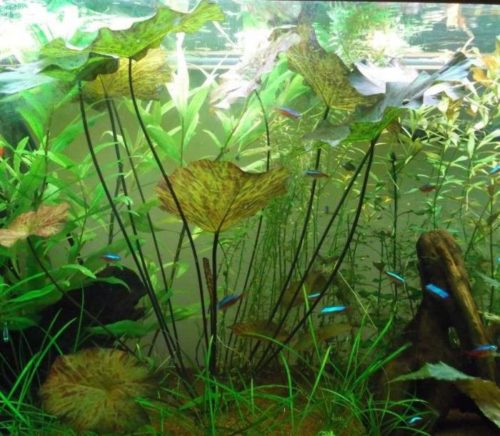
Nymphi in aquarium, species diversity
Depending on the diameter of the flower and the size of the plant, the nymphs are classified into 3 groups:
- dwarf (flower diameter from 5 to 15 cm, plant height is in the range of 15-50 cm),
- average (flower diameter from 15 to 18 cm, plant height 30 -60 cm),
- large (flower diameter from 18 to 25 cm, plants height 30 -60 cm).
The most popular and loved ones, among the aquarists, the varieties of the nymphy are the following:
- Nymphi "RUDGE".
Beautiful variety with rounded shape leaves and unusual, greenish-pink sheet of leaf plate. The plant forms leaves depending on the volume of water in the aquarium. In winter, the development of the monophia slows down.
- Nymphi "Mikranta".
A variety with underwater and surface leaves painted in green, with a brown tint, color. In height, the plant reaches no more than 35 cm. The appearance of surface leaves is indicated by the approach of the bloom of the nymphi.
- Nymphus "Stellata".
Nymphus "Stellata" in the aquarium is a chic spreading plant with large leaves of a reddish shade. The variety is demanding and needs a nutritional quality soil. When creating favorable conditions in aquarium, nymphy forms a beautiful star flower, a diameter of up to 14 cm. Color color varies and can be white, red, blue or pink, with light edging along the edge.
- Nymphi "Vivorbishy".
A variety is distinguished by unusual coloring leaves: bright green with burgundy splashes. The culture is unpretentious and grows in almost any medium (regardless of the rigidity and acidity of water).
The genus nymphi includes more than 50 species. Consider the most popular and adapted to aquarium conditions, a variety of plants.
Nymphya Red in aquarium
- This species is ideal for growing in the home aquarium. Unpretentious and hardy culture was led in its time by artificially.
- The main decoration of this type of nymphy is beautiful bright leaves painted in red-burgundy tones. Moreover, young leaflets have, lighter color and solid shape of a sheet plate, rather than adult copies.
- Nymphy red grows up to half a meter in height and, about so much width. Thus, a luxurious plant occupies a large area in aquarium and suppresses growing a number of other, light-affiliated aquatic plants.
- Leaves of the Nimfei can float on the surface or remain immersed in water.
- Nymphyus multiplies red mainly with the help of roasting processes.
Nymphi burgundy in aquarium
- According to the name of the presented type of nymphy, the leaves of the plant differ in saturated burgundy color.
- Nymphi burgundy is one of the most beautiful cultures of this kind.
- The height of the adult plant, as a rule, does not exceed 40 cm. It is important to take into account that for the normal development of the nymphs it is necessary free space, so it is not advisable to plant many copies in a small, in area, aquarium.
Nymphi Tiger in aquarium
- Outwardly, Nymphany Tiger reminds the usual pitiful man. The plant is usually blooming at night, demonstrating a very beautiful snow-white flower.
- This species is one of the most common among the owners of aquariums.
- A variety is distinguished by an unusual coloring leaves. They can be painted in a juicy green or light olive color, so nymph is often also called "green." The main difference of this type of nymphi from other representatives of the genus is brown engines or stains on the leaves resembling a tiger color. And when the sun turns onto the leaf plate, the inverse side acquires a purple shade.
- In the height of the plant can reach a 60 centimeter mark. The dimensions of the individual sheet of the nymphi vary from 5 to 15 cm.
- This species is absolutely unpretentious and easily divorced at home. Nymphany Tiger is distinguished by a rapid growth rate and easily multiplies, forming a lot of additional processes. If you ignore the formation of new processes and not to overtake them, the aquarium will very soon to resemble "impassable thickets".
- In addition to the vegetative way, the nymphy green is multiplied with seeds that are formed after flowering. If seeds get into the ground, young copies of water nymph are developing.
- Small leaves of the nymphy tiger are located on high stiffs and are evenly distributed over the entire area of \u200b\u200bthe aquarium. Noteworthy is the fact that with a lack of water, the leaves begin to grow, significantly increasing in size.
- The root system of the nymphs is green powerful and branched.
Nymphi, Growing Features in Aquarium
Most aquarists agree that they are not so easy to grow nitifia in aquarium. An aqueous plant requires the observance of a number of conditions relating to the landing, conditions of detention and care.
The choice of aquarium for nymph
- First of all, when landing nymphii, it is important to choose a suitable aquarium in size. Small, close "homemade reservoir" will not be able to accommodate growing splashing nymph and it will look ridiculous.
- The aquarium must be spacious and deep, at least 50 cm high.
The conditions of the detention of the nifia in the aquarium
- For successful cultivation of the nymphi in the aquarium, it is important to take into account key criteria: water quality, temperature and lighting.
- Nymphi prefers soft water and a weakly acidified medium, with a pH level of about 6-6.5. To ensure the desired level of acidity in the ground, humic acids can be made. In rigid water, the plant does not bloom and grows only in width, while the leaves are minced. In addition, the nymphany reacts negatively to the frequent change of water in the aquarium, the culture feels more favorable in a slightly standing water.
- The optimal temperature regime for the cultivation of the nymphi is the range from +24 0With up +28 0C. In general, for aquarium content, both plants and animals, it is not desirable to sharp temperature fluctuations in one direction or another. At a lower temperature, the plant slows down growth, does not bloom.
- For the normal development of the nymphi, high-quality nutritional soil should be prepared. The usual layer of pebbles in this case is not suitable. It is best to use mixtures of small pebbles with clay or peat with clay. Clay is used, since it contains the necessary plants, humic acids. In addition to the specified components in the soil substrate, you can add some charcoal. The thickness of the finished soil is about 6-7 cm.
- The plant "for a long day", Nymphany needs lighting for 10-12 hours a day. It is important to provide a culture with good lighting through sunlight or fluorescent lamps (special phytolambes are also suitable). It is important to prevent the close location of the lamps, to avoid burns of vegetation. Ordinary incandescent lamps for lighting aquarium are not suitable. The lack of light negatively affects the appearance of the pita: the stem is lengthened and thinned, the leaves are minced and pale.
Nymphi, landing features in aquarium
- When buying the root of the nymphy, it is important that it is solid to the touch, without any external damage and defects.
- A nutritional soil is preparing to the aquarium before boarding the aquarium (see the description of the composition in the previous section), which is stacked at the bottom of the tank and slightly tamper.
- Excellent proven such a feeding for water nymphs as bone flour. It can not be powdered in neither the soil substrate, neither on the surface of the soil in the first case, the flour will dissolve and quickly pollute the water of the aquarium, and in the second - it will be washed away with water and the benefit of the plant will not receive any. Therefore, when landing, bone flour and clay balls are preparing, which are placed directly under the root of aquatic plant.
- Nymphi is placed in the prepared ground, while trying not to plunge the point of growth.
- So that the plant does not come across, and the ground was not blurred with water, a little small pebbles are poured on top of the soil.
- If there is a large aquarium alternative to landing nimfei, there will be plant landing in a separate container, for example, a clay pot. At the bottom of the pot, a layer of shallow pebbles is damped, then 2 \\ 3 pots are filled with a mixture of garden land, humus and sand. At the same time, experienced aquarists do not recommend the use of the "shop" land enriched with special substances, which can negatively affect the "live" content of the aquarium.
- Further, the root of the nifs is placed in a pot with soil substrate and fall asleep with sand mixed with pebbles (so that the land is not washed with water).
- Lined in a pot nymfechi is placed in aquarium. Aquarium fish will appreciate the new plant, because they will have the opportunity to satisfy their needs in trace elements and other beneficial substances.
Nymphi in aquarium, plant care
Nymphi requires increased attention and painstaking care from its owner.
- Water in the aquarium should not be changed too often, the plant is better developed into a slightly stagnant water. Then the flowering of perennial becomes more intense, and the color of the leaves is still rich. It is recommended to replace about 1 \\ 5 of the water from the total aquarium once every 3 weeks.
- As for any other plant, nymphany needs periodic feeding. Therefore, 1-2 times a week, complex mineral fertilizers containing iron salts should be made. The lack of this element leads to the yellowing of the foliage of the pita.
- Limited conditions of the aquarium require the implementation of measures that restrain the intensive growth of the plant. Most often, the aquarists try to leave shoots that do not exceed 50 cm. In addition, when pruning surface leaves, the growth of underwater leaves is stimulated. It is also useful to periodically cut forward "thickets" of the nymphs and delete the emerging young root processes.
- If Nymphy is planted in a separate pot (placed inside an aquarium), the plant will require the annual spring transplant with a full soil update and, in the case of the growing roots, the use of larger (in size) pot. The timing of the year for transplanting Nymfei is not accidental, since it is even early in the spring, the plant is still in a state of rest and best transfers this procedure.
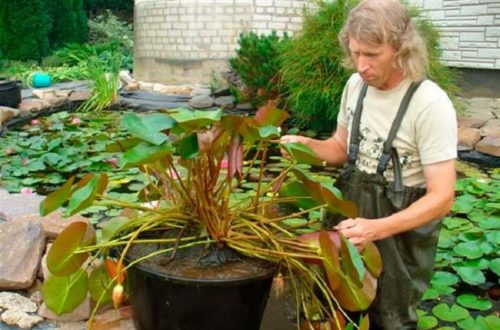
Reproduction of the nymph in aquarium
Nymphya breeds the vegetative and generative (seed) method.
- The vegetative method of reproduction is carried out due to the formation of root processes on the rhizome, which are laid out and disembark separately. Twisted young processes when they reach a length of at least 15 cm. The processes are not very well tolerated by this manipulation and slowly adapt to new conditions of existence.
- The reproduction of seeds is a long and painstaking process. To independently get nymphi seeds, the plant is subject to artificial pollination. To do this, use the usual soft brushes (for drawing), which is carried out several times on sneakers of petals. The procedure is best to spend in the morning when Nymphi is awakened. With successful pollination, after flowering, seeds are formed, which are collected for further germination. Seeds of the nymphs are planted in a container with peat, well spilled with dilated water, slightly pressing them into the substrate. The seedlings appeared in a separate container with a peat and sand mixture. Care of seedlings includes watering water temperature and feeding. Well developed seedlings planted at a permanent place.
Difficulties in growing nymphi in aquarium
- Why yellow leaves are nimfei?
Most likely, the plant is lack of iron. Pretty plants with appropriate fertilizers will eliminate this problem.
- What are the leafy of the nifia in the aquarium die?
Often, the leaves of the Nimifiy die after landing (or transplantation) when the plants adapt to new habitat conditions occurs. Another reason can be lack of lighting in the aquarium.
- Why is Nymphya in aquarium not growing?
The cause of slow-down nymphy growth may be a meager ground and lack of nutrient elements. Making feeding will help to correct this situation.
- Why did the leaves begin to stretch to the surface?
The reason may be insufficient lighting.
Thus, an exotic water plant, nymphy, requires increased attention and compliance with the basic rules of content in the aquarium. But, once, having learned to "cope" with a water beauty, in the future there will be no problems with the cultivation of Nimfei. Beautiful, catchy plant will become a real decoration for any aquarium.

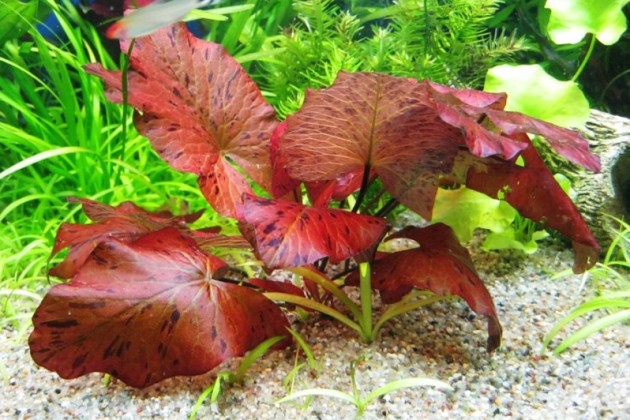
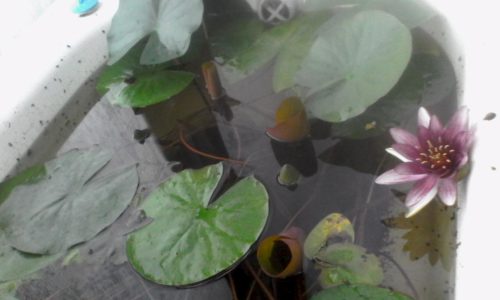
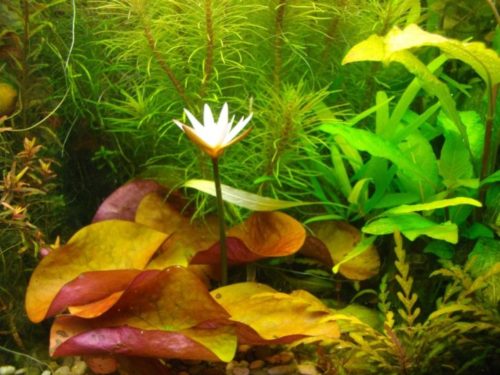
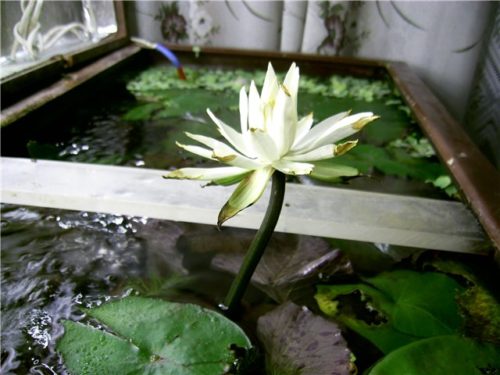
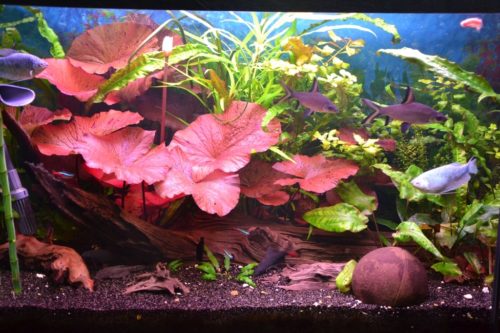
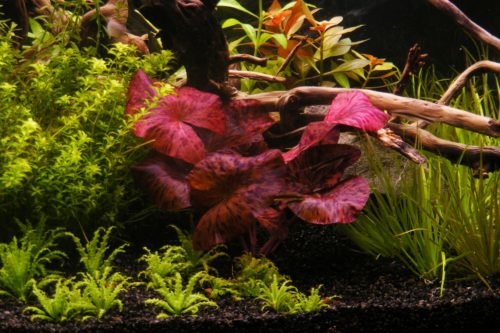
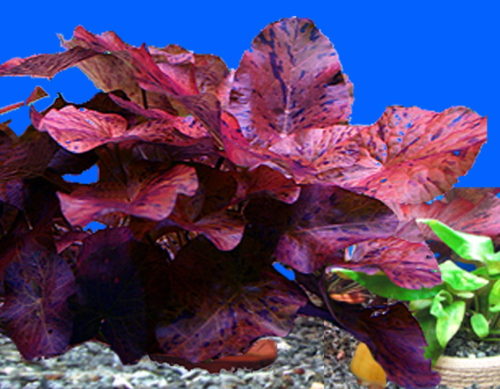
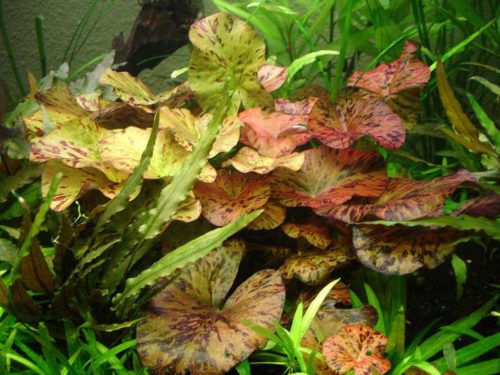
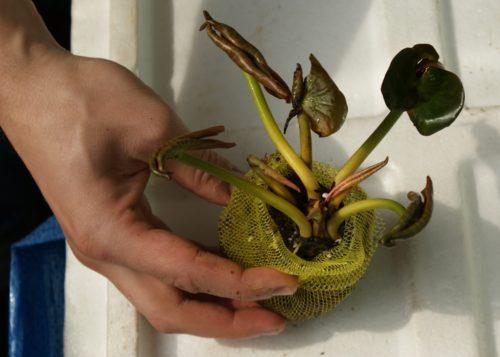

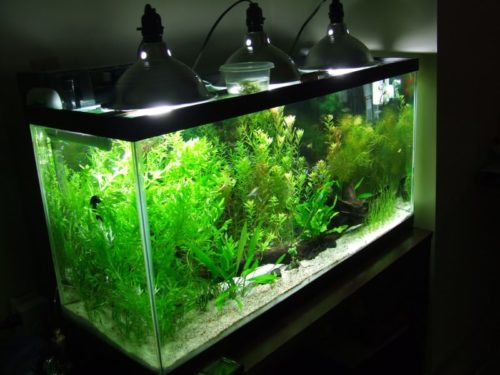
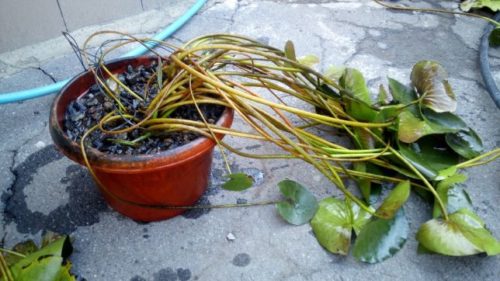
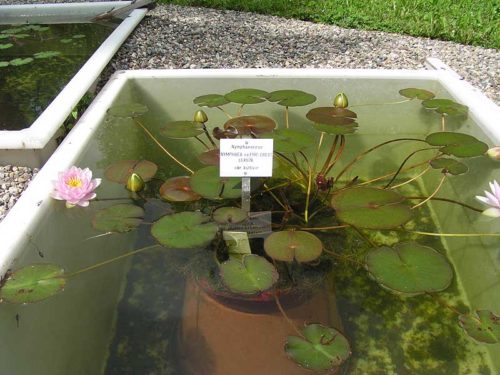
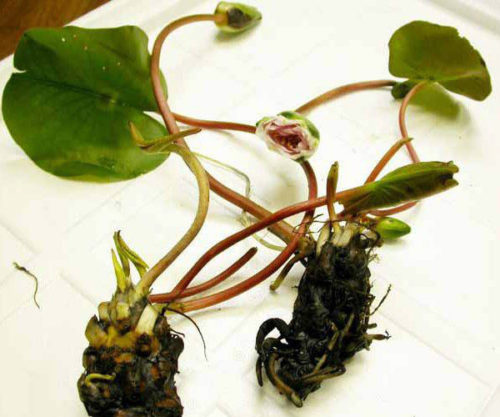
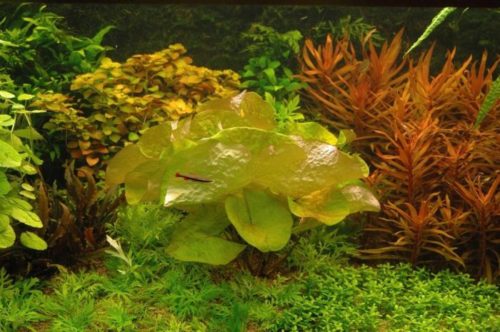

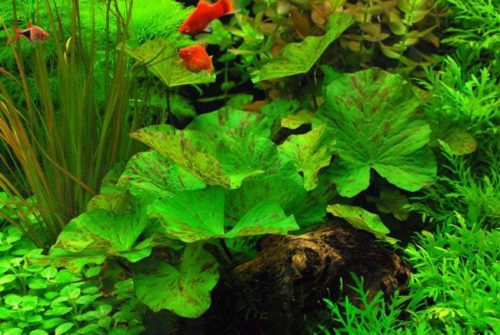
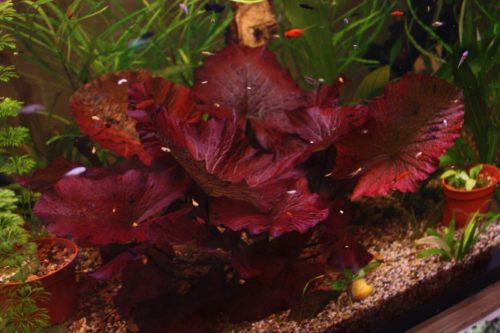












 Start a discussion ...
Start a discussion ...